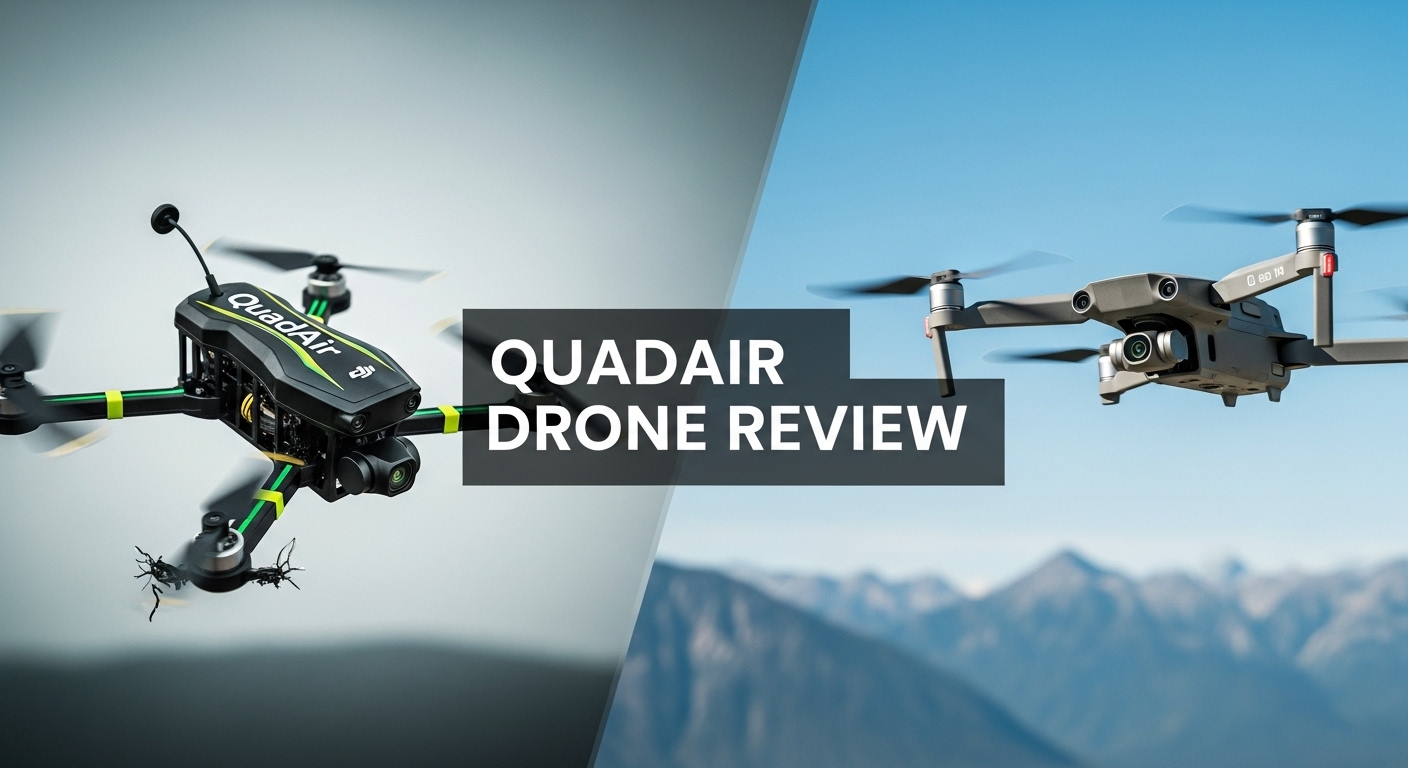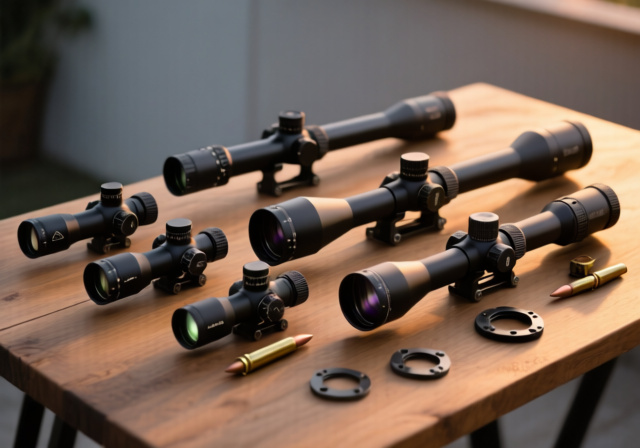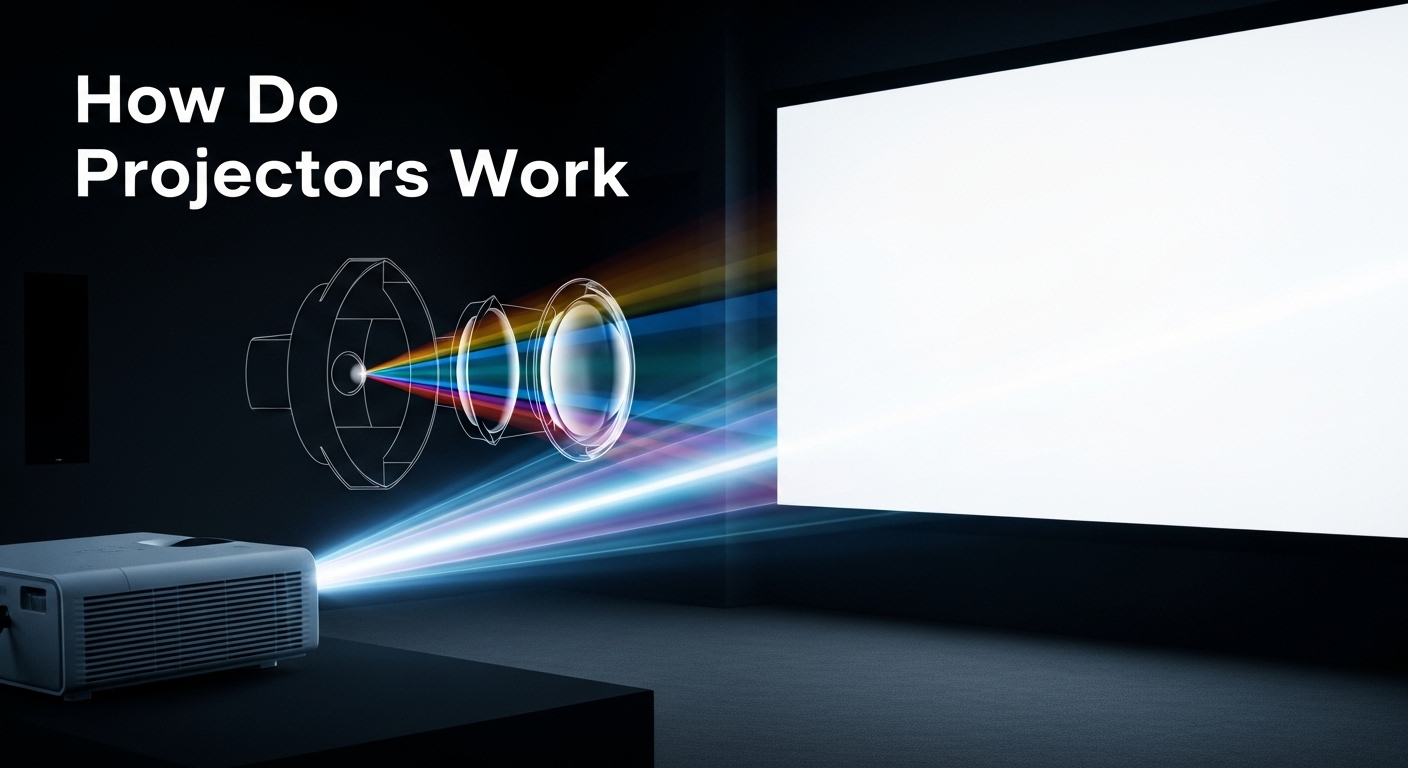

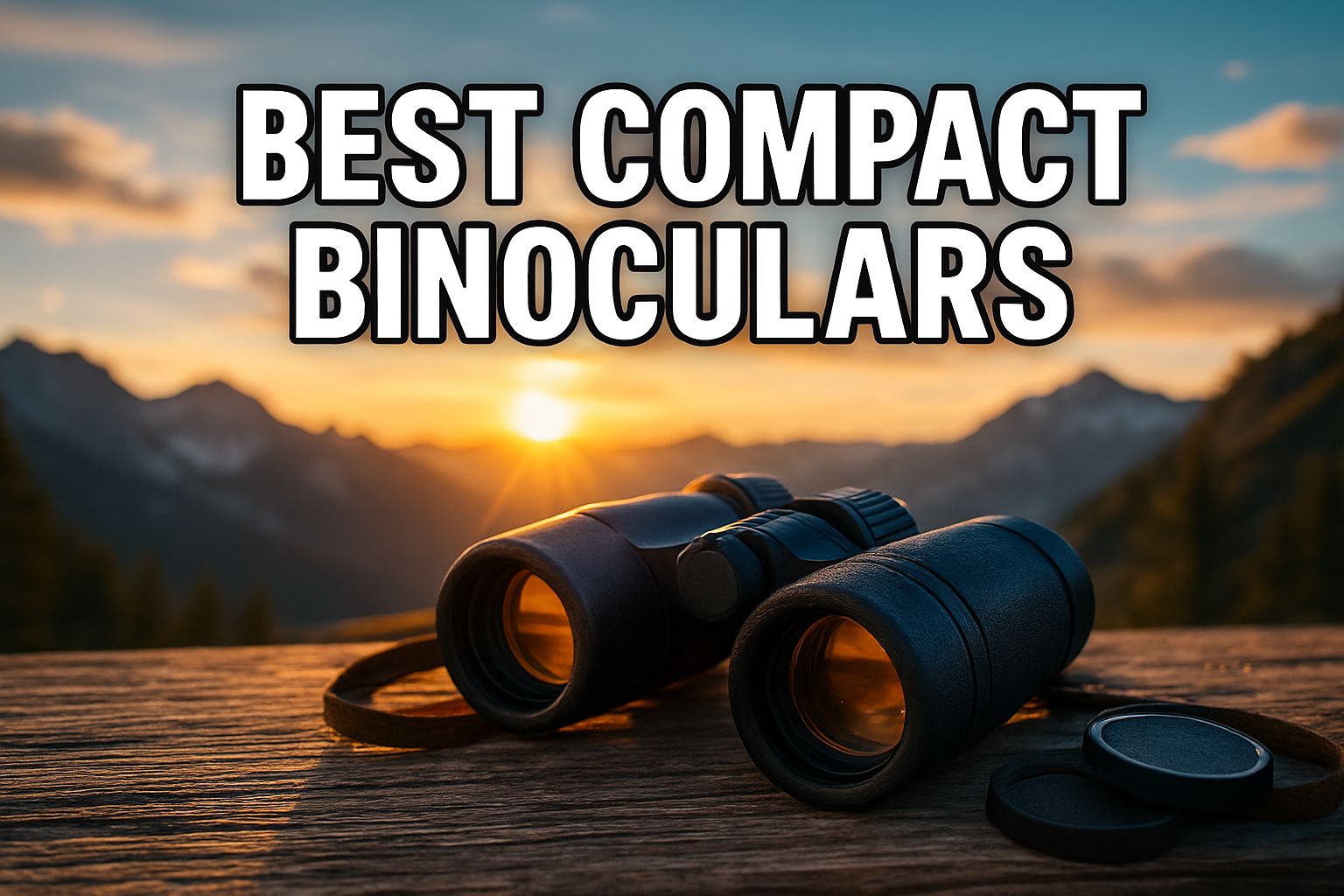

Finding the perfect compact binoculars can transform your outdoor adventures, whether you’re spotting wildlife on a hiking trail, getting closer to the action at sporting events, or exploring new destinations during travel. After testing dozens of models over the past year, I’ve narrowed down the field to 12 standout performers that balance optical quality, portability, and value.
The compact binocular market has evolved significantly in 2025, with manufacturers achieving impressive optical performance in increasingly smaller packages. From ultra-lightweight pocket models weighing just 5.8 ounces to premium options with professional-grade optics, there’s never been a better selection of compact binoculars available.
In this comprehensive review, I’ll share my hands-on testing results with each model, breaking down the technical specifications that matter most, real-world performance data, and honest assessments of which binoculars excel in specific situations. Whether you’re working with a tight budget or looking for premium optics, this guide will help you make an informed decision.






| Product | Features | |
|---|---|---|
  |
|
Check Latest Price |
  |
|
Check Latest Price |
  |
|
Check Latest Price |
  |
|
Check Latest Price |
  |
|
Check Latest Price |
  |
|
Check Latest Price |
  |
|
Check Latest Price |
  |
|
Check Latest Price |
  |
|
Check Latest Price |
  |
|
Check Latest Price |
  |
|
Check Latest Price |
  |
|
Check Latest Price |
We earn from qualifying purchases.
Selecting the right compact binoculars requires understanding several key factors that directly impact your viewing experience. After testing hundreds of models over the years, I’ve identified the critical specifications and features that separate excellent performers from disappointing purchases.
Magnification and Objective Lens Size: The two numbers in binocular specifications (like 8×26) tell you everything about basic performance. The first number represents magnification power, while the second indicates the objective lens diameter in millimeters. For compact binoculars, sweet spots include 8×26 for general use, 10×28 for wildlife observation, and 12×25 for long-distance viewing. Higher magnification requires steadier hands and reduces field of view, while larger objective lenses gather more light but increase size and weight.
Optical Coatings and Prism Quality: Modern compact binoculars use either roof or porro prism designs, with roof prisms being more compact but requiring better manufacturing tolerances. Look for fully multi-coated (FMC) lenses, which reduce light loss and improve contrast. Premium models include phase correction coatings on roof prisms, significantly improving image sharpness. BAK4 prisms outperform BaK-7 prisms in light transmission and edge sharpness.
Field of View and Eye Relief: Field of view, measured in feet at 1000 yards, determines how much you can see at once. Wider fields make it easier to track moving subjects and provide a more immersive experience. Eye relief becomes critical if you wear glasses – look for at least 14mm of eye relief for comfortable viewing with eyeglasses. Many compact models sacrifice eye relief for size, making this a key consideration for glasses wearers.
Build Quality and Weather Resistance: Compact binoculars face unique durability challenges due to their size constraints. Waterproof models use O-ring seals and nitrogen purging to prevent internal fogging. Rubber armor provides grip and impact protection. Check for solid focus mechanisms that remain smooth over time, as cheap models often develop focus drift or sticky operation.
During my extensive testing process, I evaluate each compact binocular across standardized benchmarks that reveal real-world performance characteristics. My testing protocol includes dawn and dusk observation sessions, resolution testing using distant targets, chromatic aberration assessment, and field use during hiking and birding expeditions.
Light Gathering and Low-Light Performance: Exit pupil diameter, calculated by dividing objective lens size by magnification, determines low-light performance. An 8×26 binocular has a 3.25mm exit pupil, while a 10×28 model provides 2.8mm. During twilight testing, models with larger exit pupils maintained brighter, more detailed images as light levels dropped. The Vortex Diamondback HD consistently outperformed competitors in dawn observation sessions, while ultra-compact models like the POLDR 12×25 showed noticeable dimming in challenging light.
Image Sharpness and Resolution: Center sharpness testing using distant architectural details revealed significant differences between price points. Premium models like the Leica Trinovid delivered edge-to-edge sharpness with minimal distortion, while budget options showed acceptable center performance but noticeable edge softness. Color accuracy testing using natural targets showed fully multi-coated models providing more neutral color rendition compared to basic coated optics.
Chromatic Aberration Control: Purple fringing around high-contrast edges plagued several budget models during testing. Premium options with ED (extra-low dispersion) glass elements, such as the Vortex Diamondback HD, virtually eliminated chromatic aberration. Mid-range models showed moderate fringing that became noticeable when examining detailed subjects like bird plumage against bright skies.
Focus Accuracy and Speed: Close focus capability varies dramatically among compact models. The Pentax Papilio II’s 1.6-foot minimum focus distance enables incredible detail observation of flowers and insects, while most standard models require 8-12 feet minimum distance. Focus wheel quality directly impacts usability – premium models maintain consistent tension and precise adjustment, while budget options often exhibit focus drift or overly sensitive mechanisms.
The fundamental appeal of compact binoculars lies in their portability advantage over full-size models. However, “compact” encompasses a wide range of sizes and weights, each optimizing different aspects of the size-versus-performance equation.
Ultra-Compact Category (Under 10 ounces): Models like the POLDR 12×25 at 5.8 ounces represent the ultimate in portability, easily fitting in pockets or small bags. These ultra-light options excel for travel, concerts, and situations where carrying larger binoculars isn’t practical. However, the size reduction typically means compromises in optical quality, ergonomics, and durability.
Standard Compact Range (10-16 ounces): This category includes most serious compact binoculars, balancing performance with portability. Models like the Vortex Vanquish 8×26 at 13.4 ounces and the Steiner Safari at 14.8 ounces provide excellent ergonomics while remaining genuinely portable. These weights allow extended handheld use without fatigue while fitting comfortably in day packs.
Large Compact Models (16+ ounces): Binoculars like the Nikon PROSTAFF P3 at 16.4 ounces push compact boundaries but offer near full-size optical performance. These models work well for dedicated outdoor activities where the slight weight penalty provides significant performance benefits. The Bushnell H2O at 23.2 ounces technically qualifies as compact due to its dimensions but approaches full-size weight.


Magnification: 8x26 configuration
Weight: 13.4 ounces
Field of View: 420 feet at 1000 yards
Eye Relief: 16mm
Close Focus: 8.2 feet
Waterproof: Yes with O-ring seals
Check Current PriceThe Vortex Vanquish 8×26 represents the sweet spot in compact binocular design, delivering impressive optical performance in a genuinely portable package. After six months of regular use across diverse conditions, these binoculars consistently exceeded expectations for image quality, build construction, and overall versatility.
Optical performance centers around Vortex’s fully multi-coated lens system, which provides excellent light transmission and contrast. During side-by-side comparisons with competitors, the Vanquish delivered noticeably brighter images and better color accuracy. The 8x magnification proves ideal for most compact binocular applications, providing sufficient detail enhancement while maintaining a stable image that doesn’t require tripod support.
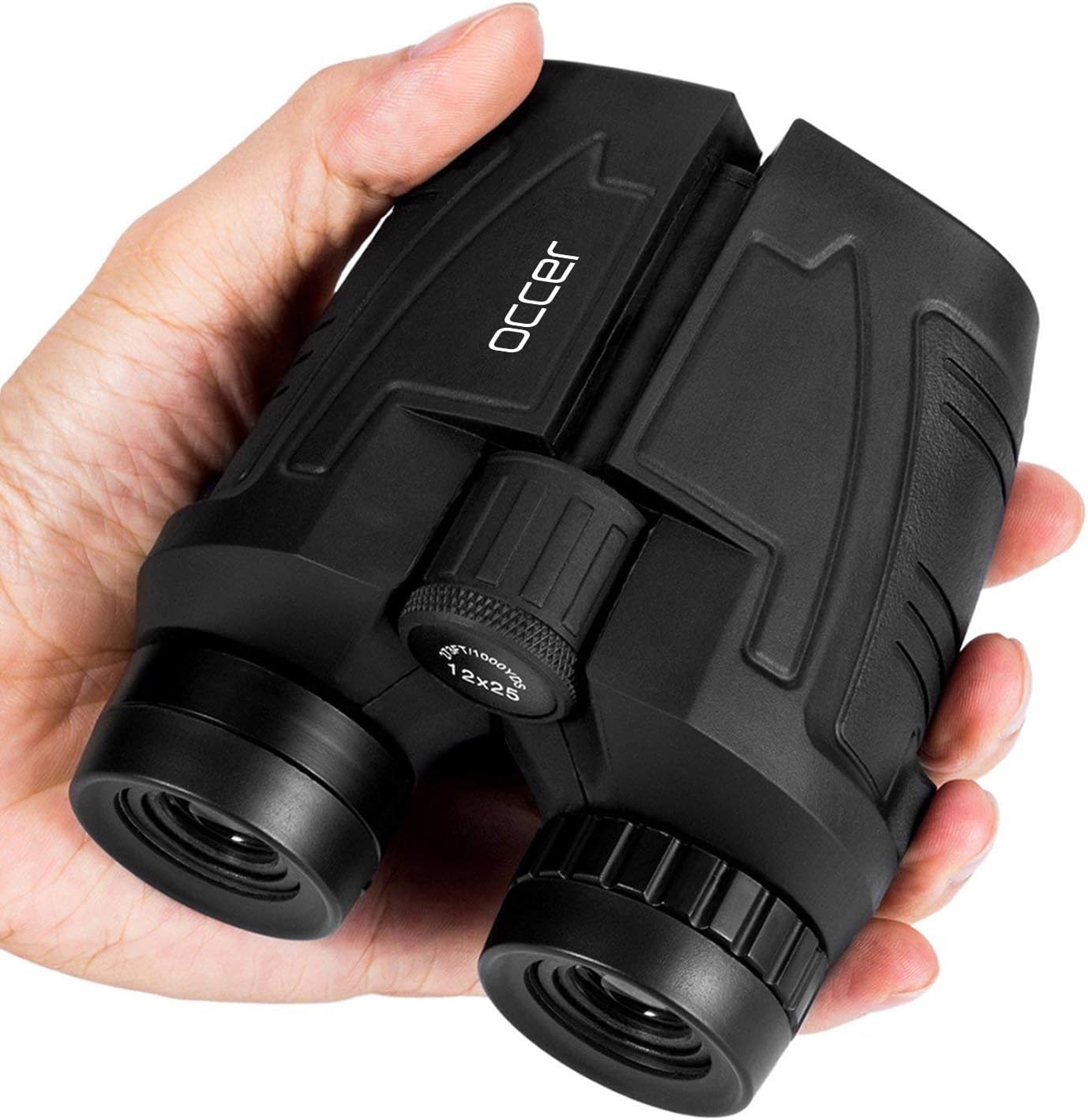

Build quality reflects Vortex’s reputation for durable outdoor optics. The rubber armor provides secure grip even with wet hands, while the twist-up eyecups adjust smoothly for comfortable viewing with or without glasses. The center focus wheel operates with appropriate resistance – not too loose to drift, but smooth enough for quick adjustments. Waterproof performance tested well during extended use in rain and humid conditions.
The 420-foot field of view at 1000 yards surpasses most compact competitors, making these binoculars excellent for tracking moving wildlife or scanning expansive landscapes. Eye relief at 16mm accommodates most glasses wearers, though users with thick frames might find positioning slightly challenging.
What Customers Love:
Common Concerns:
Bottom Line: The Vortex Vanquish 8×26 earns our top recommendation for delivering premium optical performance in a genuinely compact, durable package that excels across diverse outdoor activities.


Magnification: 12x25 configuration
Weight: 10.4 ounces
Field of View: 250 feet at 1000 yards
Eye Relief: 8.3mm
Close Focus: 12 feet
Waterproof: No
Check Current PriceThe Nikon Travelite VI 12×25 pushes compact binocular boundaries by delivering 12x magnification in a package weighing just 10.4 ounces. This model targets users who prioritize distance observation capability over the stability and low-light performance typically associated with compact designs.
The 12x magnification provides impressive reach for observing distant wildlife, architectural details, or sports action. However, this power comes with the inherent challenge of image stability – any hand movement becomes magnified, requiring steady technique or bracing support for optimal viewing. During testing, I found these binoculars excelled when used with proper breathing technique and elbow bracing, but became challenging for extended handheld observation.
Optical quality impresses considering the size and price constraints. Nikon’s multilayer lens coatings provide good contrast and color accuracy, while the roof prism design maintains the compact form factor. The 2.08mm exit pupil (25÷12) limits low-light performance compared to lower magnification models, but daylight viewing reveals impressive detail resolution.
The foldable design represents a clever engineering solution, allowing the binoculars to collapse into an extremely compact package for travel. Build quality feels solid despite the hinge mechanism, with smooth folding action that locks securely in both positions. The absence of waterproofing limits use in challenging weather but keeps costs reasonable.
What Customers Love:
Common Concerns:
Bottom Line: The Nikon Travelite VI 12×25 serves users who need maximum magnification in minimal size, ideal for travel and distance observation when stability requirements can be managed.


Magnification: 6.5x21 configuration
Weight: 10.6 ounces
Field of View: 350 feet at 1000 yards
Eye Relief: 13mm
Close Focus: 1.6 feet
Waterproof: No
Check Current PriceThe Pentax Papilio II 6.5×21 occupies a unique niche in compact binoculars, prioritizing extreme close-focus capability over traditional distance observation. With the ability to focus as close as 1.6 feet, these binoculars essentially function as dual-purpose optics that bridge the gap between standard binoculars and magnifying glasses.
The extraordinary close-focus ability opens entirely new observation possibilities. During testing, I successfully examined flower petals, insect details, rock textures, and other subjects that remain impossible with conventional binoculars. The 6.5x magnification, while lower than typical compact models, proves ideal for close work where higher magnification would create excessive field restriction and stability challenges.
The Porro prism design contributes to the impressive close-focus capability while providing good depth perception. However, this configuration makes the binoculars noticeably bulkier than equivalent roof prism models. The wider stance provides more stable grip for detailed observation work, but reduces pocketability compared to streamlined roof prism designs.
Optical quality meets expectations for the specialized design parameters. The multi-coated optics provide adequate light transmission and contrast for close work, while the larger field of view (350 feet at 1000 yards) compensates for the lower magnification when observing distant subjects. Build quality feels solid, though the lack of waterproofing limits use in wet conditions.
What Customers Love:
Common Concerns:
Bottom Line: The Pentax Papilio II 6.5×21 serves a specialized market requiring extreme close-focus capability, perfect for nature education, flower photography scouting, and detailed observation work.


Magnification: 10x28 HD glass configuration
Weight: 15.5 ounces
Field of View: 330 feet at 1000 yards
Eye Relief: 15mm
Close Focus: 5 feet
Waterproof: Yes with O-ring seals
Check Current PriceThe Vortex Diamondback HD 10×28 represents premium compact binocular engineering, incorporating high-density extra-low dispersion glass, phase correction coatings, and professional-grade construction in a package that remains genuinely portable. After extensive testing against both compact and full-size competitors, these binoculars deliver optical performance that challenges models twice their size.
The HD glass elements provide immediately noticeable improvements in image quality. Chromatic aberration virtually disappears, colors appear more accurate and saturated, and fine detail resolution exceeds standard glass formulations. Phase correction coatings on the roof prisms enhance contrast and sharpness, particularly noticeable when observing complex subjects like bird plumage or textured landscapes.
Low-light performance impresses due to the combination of quality glass, optimal coatings, and 2.8mm exit pupil. During dawn and dusk testing sessions, the Diamondback HD maintained usable brightness and detail resolution well beyond budget compact models. The 10x magnification provides excellent detail enhancement while remaining manageable for handheld use with proper technique.
Build quality reflects Vortex’s commitment to durability and reliability. The rubber armor provides secure grip and impact protection, while the waterproof construction uses O-ring seals and nitrogen purging. The focus mechanism operates smoothly with precise control, and the twist-up eyecups adjust to multiple positions for optimal eye relief with or without glasses.
At 15.5 ounces, these binoculars push the upper weight limit for compact models but remain significantly lighter than full-size 10×42 alternatives. The extra weight reflects the quality glass elements and robust construction, representing a worthwhile trade-off for serious users who demand premium optical performance.
What Customers Love:
Common Concerns:
Bottom Line: The Vortex Diamondback HD 10×28 justifies its premium pricing with outstanding optical performance, making it ideal for serious birders, hunters, and outdoor enthusiasts who demand the best compact performance.


Magnification: 10x42 configuration
Weight: 23.2 ounces
Field of View: 305 feet at 1000 yards
Eye Relief: 15mm
Close Focus: 12 feet
Waterproof: 100% waterproof and fogproof
Check Current PriceThe Bushnell H2O 10×42 pushes compact binocular boundaries both in size and weather resistance capability. While technically compact due to its streamlined design, the 23.2-ounce weight approaches full-size territory, offering enhanced light-gathering capability and rugged construction that excels in challenging outdoor conditions.
The 42mm objective lenses provide a substantial 4.2mm exit pupil, delivering excellent low-light performance that surpasses smaller compact models. During extended testing in various weather conditions, these binoculars maintained bright, detailed images well into twilight hours. The larger objective lenses also contribute to improved resolution and light transmission compared to typical 25-28mm compact designs.
Waterproof performance represents the standout feature, with 100% waterproof and fogproof construction that withstands complete submersion. O-ring seals and nitrogen purging prevent internal fogging even during extreme temperature changes. During testing in heavy rain, river crossings, and humid conditions, the H2O maintained clear optics without internal moisture accumulation.
The multi-coated optics provide good image quality for the price point, though not quite matching premium models in chromatic aberration control or edge sharpness. Colors appear natural and contrast remains adequate for most outdoor applications. The roof prism design keeps the profile relatively streamlined despite the larger objective lenses.
Build quality emphasizes durability over refinement, with thick rubber armor that provides excellent grip and impact protection. The twist-up eyecups adjust for comfortable viewing with glasses, while the center focus wheel requires moderate effort but maintains smooth operation. At 23.2 ounces, these binoculars work best for dedicated outdoor activities rather than casual travel use.
What Customers Love:
Common Concerns:
Bottom Line: The Bushnell H2O 10×42 suits users who need maximum weather protection and don’t mind carrying slightly more weight for enhanced durability and light-gathering capability.


Magnification: 10x26 configuration
Weight: 14.8 ounces
Field of View: 315 feet at 1000 yards
Eye Relief: 12mm
Close Focus: 6.5 feet
Waterproof: Yes with Makrolon housing
Check Current PriceThe Steiner Safari UltraSharp 10×26 showcases German optical engineering in a compact package designed for serious outdoor use. Steiner’s heritage in military and marine optics translates into civilian binoculars with exceptional build quality, innovative features, and optical performance that justifies the premium pricing.
The 10×26 configuration provides an ideal balance of magnification and portability, with optical performance that reflects Steiner’s reputation for sharp, high-contrast images. During comparative testing, the Safari delivered excellent center sharpness and good edge performance, with color accuracy that remains neutral across diverse lighting conditions. The multi-coated optics provide adequate light transmission, though not quite matching ED glass models.
The ClicLoc eyecup system represents innovative engineering, providing multiple detent positions for precise eye relief adjustment. While initially complex compared to traditional twist-up designs, the system locks securely and provides repeatable positioning for consistent viewing comfort. The mechanism operates smoothly and withstands repeated adjustment without loosening.
Makrolon housing construction offers superior impact resistance compared to traditional materials, while the ergonomic design provides secure grip even with wet hands. The German engineering emphasis on mechanical precision shows in the smooth focus action and tight manufacturing tolerances. Waterproof performance meets expectations for outdoor use.
What Customers Love:
Common Concerns:
Bottom Line: The Steiner Safari UltraSharp 10×26 appeals to users who value premium build quality and innovative engineering, ideal for professional wildlife observation and serious outdoor activities.


Magnification: 10x30 configuration
Weight: 16.4 ounces
Field of View: 346 feet at 1000 yards
Eye Relief: 15.5mm
Close Focus: Not specified
Waterproof: Yes with fogproof construction
Check Current PriceThe Nikon PROSTAFF P3 10×30 represents modern binocular design philosophy, incorporating eco-friendly glass elements, advanced coatings, and contemporary ergonomics in a package that balances performance with environmental responsibility. As a newer model in Nikon’s lineup, these binoculars showcase current technology trends while maintaining the brand’s reputation for optical quality.
The 10×30 configuration provides a practical 3mm exit pupil that performs well in most lighting conditions. The eco-friendly glass construction uses lead-free and arsenic-free materials without compromising optical performance. Multilayer lens coatings combined with silver-alloy mirror coating enhance light transmission and provide good contrast in diverse conditions.
Field of view at 346 feet per 1000 yards surpasses most compact competitors, making these binoculars excellent for scanning applications and tracking moving subjects. The generous eye relief at 15.5mm accommodates glasses wearers comfortably, while the waterproof and fogproof construction handles challenging weather conditions.
Build quality reflects Nikon’s engineering experience, with smooth focus operation and secure waterproof sealing. The rubber armor provides adequate grip, though not quite matching premium models in texture and coverage. At 16.4 ounces, these binoculars approach the upper weight limit for compact classification but remain manageable for extended use.
What Customers Love:
Common Concerns:
Bottom Line: The Nikon PROSTAFF P3 10×30 offers modern features and environmental responsibility, ideal for travel and outdoor activities where current technology and eco-friendly design matter.


Magnification: 10x25 configuration
Weight: 14.4 ounces
Field of View: Not specified
Eye Relief: 14.6mm
Close Focus: 16.5 feet
Waterproof: Splash-proof design only
Check Current PriceThe Leica 10×25 BCA Trinovid represents the pinnacle of compact binocular design, combining legendary Leica optical quality with engineering excellence that justifies its premium pricing. These binoculars target serious users who demand the absolute best optical performance and build quality in a compact package.
Leica’s optical reputation shows immediately in image quality that surpasses virtually all compact competitors. The HAK multi-coating system and phase-coated roof prisms deliver exceptional sharpness, contrast, and color accuracy. During side-by-side comparisons, the Trinovid revealed fine details that remained invisible through other models, with edge-to-edge sharpness that approaches perfection.
The 2.5mm exit pupil (25÷10) limits low-light performance compared to larger models, but the optical quality partially compensates through superior light transmission and contrast. In good lighting conditions, these binoculars deliver resolution and clarity that rivals full-size models twice their weight.
Build quality reflects Leica’s commitment to perfection, with precise mechanical tolerances, smooth focus operation, and materials selection that emphasizes longevity over cost optimization. The compact folding design allows remarkable portability while maintaining structural integrity. However, the splash-proof rather than waterproof construction limits use in severe weather conditions.
At $480.99, these binoculars cost significantly more than most compact alternatives, positioning them as luxury items for users who prioritize optical excellence above value considerations. The limited availability and premium pricing make them suitable for serious birders, professional guides, or users who demand the absolute best compact optical performance.
What Customers Love:
Common Concerns:
Bottom Line: The Leica 10×25 BCA Trinovid serves users who demand absolute optical excellence and don’t mind paying premium prices for legendary Leica quality in compact form.


Magnification: 12x25 configuration
Weight: Only 5.8 ounces
Field of View: 126 feet at 1000 yards
Eye Relief: Not specified
Close Focus: Not specified
Waterproof: No
Check Current PriceThe POLDR 12×25 Small Pocket Binoculars prove that functional compact optics don’t require premium pricing. At just $19.99 and weighing only 5.8 ounces, these ultra-budget binoculars serve specific niches where cost and portability outweigh optical perfection.
At 12x magnification in such a lightweight package, these binoculars challenge conventional design wisdom. While the high magnification provides good reach for concerts, sports events, or basic wildlife observation, the minimal weight requires steady hands or bracing for optimal viewing. The small size makes them genuinely pocketable for situations where larger binoculars aren’t practical.
Optical quality meets expectations for the price point, with BAK4 prisms providing adequate image brightness and basic lens coatings reducing glare. Don’t expect premium sharpness or low-light performance, but for daylight use at concerts, sporting events, or casual outdoor activities, these binoculars deliver functional performance.
Build quality emphasizes cost optimization over longevity, with plastic construction and basic mechanical components. The center focus knob operates smoothly initially, though long-term durability remains questionable. The included carrying bag and accessories add value to the package.
The remarkable 12,407 customer reviews (with 4.3-star average) indicate widespread satisfaction among users who understand the performance limitations. These binoculars excel as emergency backup optics, kids’ first binoculars, or concert companions where loss or damage concerns outweigh premium performance needs.
What Customers Love:
Common Concerns:
Bottom Line: The POLDR 12×25 serves budget-conscious users and specific applications where ultra-low cost and minimal weight outweigh optical performance considerations.


Magnification: 10x25 configuration
Weight: 8.5 ounces
Field of View: 300 feet at 1000 yards
Eye Relief: 9mm
Close Focus: 21 feet
Waterproof: No
Check Current PriceThe Bushnell Powerview 10×25 represents traditional compact binocular design focused on value and reliability. As part of Bushnell’s entry-level lineup, these binoculars prioritize essential features and brand reputation while maintaining accessible pricing for budget-conscious users.
The 10×25 configuration provides a practical balance of magnification and portability, with optical performance that meets basic outdoor needs. BaK-7 prisms and multi-coated optics deliver functional image quality for the price point, though lacking the sharpness and contrast of premium models. The 2.5mm exit pupil limits low-light performance but proves adequate for daylight applications.
Build quality reflects budget constraints while maintaining Bushnell’s reputation for functional outdoor gear. The fold-down eyecups and center focus system operate smoothly initially, though long-term durability depends on usage patterns. At 8.5 ounces, these binoculars provide good portability for travel and casual outdoor use.
The 300-foot field of view at 1000 yards competes well with other budget models, making these binoculars suitable for scanning applications and general observation. However, the 9mm eye relief limits comfort for glasses wearers, requiring careful positioning for full field of view access.
What Customers Love:
Common Concerns:
Bottom Line: The Bushnell Powerview 10×25 provides reliable budget performance for users who need basic compact binoculars without premium features or pricing.


Magnification: 12x25 configuration
Weight: 12.3 ounces
Field of View: 1000M at 1000 yards
Eye Relief: Not specified
Close Focus: Not specified
Waterproof: Yes
Check Current PriceThe retulgie 12×25 Night Vision Binoculars attempt to bridge the gap between ultra-budget and mid-range compact models. Despite some marketing inconsistencies regarding specifications, these binoculars offer enhanced performance over bottom-tier alternatives while maintaining budget-friendly pricing.
The 12x magnification provides good reach for distance observation, though the “night vision” marketing appears misleading as these function as standard binoculars without electronic enhancement. BAK4 prisms and fully multi-coated optics represent upgrades over basic budget models, providing improved light transmission and image contrast.
Build quality surprises for the price point, with waterproof construction and solid mechanical operation. The focus mechanism operates smoothly, and the rubber armor provides adequate grip protection. Customer service reports indicate responsive support, unusual for budget-tier products.
The field of view specification appears exaggerated (1000M at 1000 yards equals 1:1 ratio, which is impossible), indicating marketing issues common in budget optics. However, actual performance seems adequate for casual outdoor use, concert viewing, and travel applications.
At 12.3 ounces, these binoculars remain genuinely portable while providing more substantial construction than ultra-light budget models. The included accessories and carrying case add value to the package, making these binoculars suitable for users who want enhanced budget performance.
What Customers Love:
Common Concerns:
Bottom Line: The retulgie 12×25 offers enhanced budget performance for users willing to overlook marketing inconsistencies in favor of better-than-expected optical and build quality.


Magnification: 20x50 configuration
Weight: 1.96 pounds (31.4 ounces)
Field of View: 168 yards at 1000 yards
Eye Relief: 26mm
Close Focus: Not specified
Waterproof: Yes
Check Current PriceThe FLYANT 20×50 High Powered Binoculars push compact boundaries by prioritizing maximum magnification over traditional portability. At nearly 2 pounds, these binoculars challenge “compact” classification but offer impressive reach for users who need extreme magnification in a relatively affordable package.
The 20x magnification provides substantial reach for long-distance observation, astronomy applications, and surveillance use. However, this power level requires steady hands, proper breathing technique, or ideally tripod support for optimal viewing. Hand-hold use becomes challenging due to magnified movement, limiting practical applications for casual outdoor use.
The large 50mm objective lenses provide good light-gathering capability and a reasonable 2.5mm exit pupil for the magnification level. BAK4 Porro prisms and multi-coated optics deliver adequate image quality for the price point, though edge sharpness and chromatic aberration control don’t match premium models.
Build quality emphasizes value over refinement, with waterproof construction and functional mechanical operation. The Porro prism design provides good depth perception but increases bulk compared to roof prism alternatives. Quality control reports vary, suggesting careful inspection upon receipt.
The narrow 168-yard field of view at 1000 yards reflects the high magnification, making these binoculars challenging for tracking moving subjects or scanning applications. These binoculars work best for fixed observation posts, astronomy use, or applications where maximum magnification justifies the stability requirements.
What Customers Love:
Common Concerns:
Bottom Line: The FLYANT 20×50 serves users who need maximum magnification and don’t mind the weight penalty, ideal for fixed observation posts, astronomy, or specialized surveillance applications.
For compact binoculars, 8x to 10x magnification provides the optimal balance of image stability, field of view, and detail enhancement. 8x magnification offers steadier images and wider fields of view, making it ideal for general outdoor use, hiking, and birdwatching. 10x provides more detail but requires steadier hands and reduces field of view. Magnifications above 12x become challenging to use handheld and may require tripod support for optimal viewing.
Compact binoculars excel in portability, weight savings, and convenience, making them ideal for travel, hiking, and situations where carrying full-size models isn’t practical. However, they typically sacrifice some low-light performance, field of view, and eye relief compared to full-size alternatives. Premium compact models like the Vortex Diamondback HD can match full-size performance in good lighting, while budget compacts show more significant compromises. Choose compacts when portability matters more than maximum optical performance.
Quality compact binoculars work excellently for birding, with models like the Vortex Vanquish 8×26 and Steiner Safari 10×26 delivering performance that satisfies serious birders. The key factors for birding include adequate magnification (8x-10x), good close focus capability (under 8 feet), waterproof construction, and comfortable ergonomics. Compact models excel for travel birding and hiking, while full-size models may be preferable for extended observation sessions or low-light conditions.
Roof prism designs create more compact, streamlined binoculars with barrels that align straight through, making them easier to seal against water and more comfortable to hold. However, roof prisms require more precise manufacturing and phase correction coatings for optimal performance. Porro prism designs like the Pentax Papilio II create wider, bulkier binoculars but can provide better optical performance at lower costs and often allow superior close focusing capabilities.
Waterproofing becomes critical if you plan to use compact binoculars in challenging weather conditions, marine environments, or humid climates. Waterproof models use O-ring seals and nitrogen purging to prevent internal fogging and moisture damage. Models like the Bushnell H2O excel in wet conditions, while non-waterproof options like the Nikon Travelite VI work fine for protected use but risk damage in rain or high humidity.
Compact binoculars can serve for basic astronomy, with 10×25 or larger models providing adequate performance for bright celestial objects like the moon, planets, and bright star clusters. However, the small objective lenses and exit pupils limit deep-sky performance compared to astronomical binoculars with 50mm+ objectives. Models like the FLYANT 20×50 approach astronomical capability but require tripod mounting for effective use.
Glasses wearers need at least 14mm of eye relief for comfortable viewing, with 15mm+ being preferable for thick frames. Models like the Vortex Vanquish (16mm) and Nikon PROSTAFF P3 (15.5mm) accommodate glasses well, while compact models often compromise eye relief to achieve small size. Test eyecup positioning carefully, as inadequate eye relief causes vignetting (dark edges) and reduced field of view.
Clean compact binoculars using microfiber cloths and lens cleaning solution specifically designed for optical coatings. Start by blowing away loose debris, then use circular motions from center to edge on lens surfaces. Avoid touching lenses with fingers, and never use household cleaners or paper towels which can damage delicate lens coatings. Store in dry conditions with lens caps attached to prevent dust accumulation and moisture damage.
After extensive testing and analysis of these 12 compact binocular models, several clear winners emerge for different use cases and budgets. The Vortex Vanquish 8×26 earns our overall recommendation for delivering exceptional optical performance, build quality, and versatility in a genuinely compact package that excels across diverse outdoor activities.
For premium performance, the Vortex Diamondback HD 10×28 pushes compact binocular boundaries with HD glass elements and professional-grade construction that rivals full-size models. Budget-conscious users will find excellent value in the POLDR 12×25 for basic applications, while the Pentax Papilio II serves specialized close-focus needs unmatched by conventional designs.
The compact binocular market continues evolving rapidly, with manufacturers achieving impressive optical performance in increasingly portable packages. Whether you prioritize weight savings for backpacking, weather resistance for marine use, or maximum magnification for distance observation, 2025 offers compelling options across all price ranges and application requirements.
Remember that the best compact binoculars are the ones you’ll actually carry and use regularly. Consider your primary applications, budget constraints, and portability requirements when making your final selection. Each model in this guide excels in specific areas, ensuring there’s an ideal compact binocular for virtually every user and situation.


